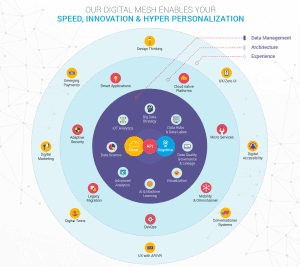
Connecting with the digital ecosystem and monetizing your own digital assets offers huge opportunities. APIs are a key frontline tool to unlock them.
Apple touched a $1 trillion valuation. At the heart of it was a business model, where it opened up innovation to the world of application developers and therefore created disruptive multi-billion dollar industries, such as the Ubers of the world. Amazon reached a $1 trillion valuation and releases new software every 11 seconds.
Early adopters such as eBay, Expedia and Salesforce, run close to 70-90% of its business on Application Programming Interfaces (APIs) and transact billions of dollars. These are the change-makers benchmarking today’s Fortune 500.
By contrast, only 12 percent of those on that list in 1955 remained in 2017, thanks to creative destruction, and the inability to out-innovate the competition. Welcome to the API economy.
No longer an afterthought, an API as a frontline tool must become the fundamental premise for how enterprises prepare to manage their own “future of unknowns” digital journeys. Even in 2019, several top-tier Fortune 100s are struggling to make up their minds decisively to commit to APIs.
See also: How to use APIs to navigate corporate mergers
Moving towards an API-first program, especially for late adopters, is one of the mandatory pivots organizations will need to consider, in order to accelerate, hyperscale, remain relevant and lay a foundation for delivering deep personalization, as they look toward a future of advanced cloud-native and AI-driven specialization.
Connecting with the digital ecosystem and monetizing your own digital assets offers huge opportunities. It is perhaps one of the most important levers you can pull to rapidly scale business models toward ever-changing buyer behaviors.
Four steps to API excellence
Based upon what I have seen with a number of successful customers, I suggest the following 4 steps to plan and accelerate an effective API-adoption strategy:
#1: Design an API-First Program
APIs essentially offer dual purpose foundation – modular design and precise metering. API enabled modular architectures gives developers the ability to independently create, subdivide and update components without impacting other parts of a larger system.
While modularity gives advantages of standardization and consistency, along with the power of customization, it also provides the operational ability to do precise metering and monitoring. Combined with the ability to partition the decision rights, makes it a powerful technical and operational foundation for platforms.
I see one of the biggest deterrents of speed in enterprises is siloed and locked development, which results in the inability to share data or seamlessly leverage the enterprise’s capability. Strongly urge enterprises to get away from this classic legacy thinking and develop an API-first approach. Think about how your developers write software and how they expose the capabilities to the larger systems.
API-first approach enables you to design code that speeds up the enterprise software development, allowing for your future cloud-native fabric to monetize and bring about a multiplier effect within your enterprise.
One of the world’s largest travel insurance customers we worked with had embarked in their digital transformation journey with an API-first approach that helped them rapidly scale up their partner network. Today, they are able to offer custom insurance products for individual travel plans for a wider network and seamlessly scale the model.
There are already numerous examples across industry verticals, like AT&T, Telstra T-Mobile in Telecom, United, Delta in Travel, Walgreens’ Photo Prints in Retail, HSBC, and other large legacy enterprises who have realized the importance and started their API-first program. By making this single fundamental change, enterprises are able to bring in amazing agility to continuously innovate.
#2: Make the Cultural Pivot – Ubiquitous & Open innovation
The global consumer market is rapidly transitioning as buying patterns are changing fast—and enterprises today really cannot afford to have 1-year Time To Value (TTV) of their new product releases and a prolonged multi-year innovation cycles. Amazon continuously delivers software more than five times each minute. Today’s hyper-evolved technology can empower you to compete with the likes of Amazon. However, the three following cultural pivots are critical to institutionalize and bring in a reimagined development and continuous innovation methodology:
Publishing vs. Siloing
As businesses mature into software-driven cloud-native enterprises with infinite scale, bringing down the marginal cost of new development is imperative to avoid re-inventing the wheel.
One of the biggest and most effective catalysts for API-first adoption is a feature-rich developer portal that encourages a great collaborative culture, binds the team with a common purpose, and promotes systemic innovation.
Embracing Open Innovation
In a fast-moving world of open innovation, there is no reason to limit your overall inventive abilities to be proportional to the size of your teams. Building a gateway channel to a smartly envisioned “open platform” approach with Software Development Kits (SDKs) and APIs can be promoted both internally and externally.
Several enterprises—Apple, AT&T, Cisco, for example—have fully embraced data-sharing programs to innovate their operations and customer service by opening their API gateway service so developers can build and run secure APIs.
Adopting Hackathons as a Way of Life
Successful enterprises have embraced hackathons to effectively energize the development community, internal teams and partner ecosystems, and drive better and faster stakeholder experiences.
Hackathons offer phenomenal results to:
- Drive customer centric innovation
- Break internal silos and open up the art of possibilities, with tremendous cross-functional collaboration and sharing.
- Challenge the order and bring cool hacks to surface.
- Infuse a sense of “intrapreneurial” urgency and a culture of innovation in the DNA.
#3: Treat APIs as Products — Design Programs to Manage them as Products
Every enterprise now has the ability to house a Silicon Valley start-up in its floor. Simply put, there is a tremendous opportunity for every enterprise to own an in-house platform for inventing new products and services, with API at the heart of innovation and experience.
A comprehensive API management tool and right-thinking processes are essential for managing the ideation, development, publishing, versioning, and retirement. Thankfully, over the past decade, the API management ecosystem has rapidly evolved to support innovation and development cycles.
API management stacks adeptly isolate functionality and provide seamless transitions between ecosystems. Additionally, security can be integrated via the APIM without changing existing software, making migration of legacy systems more cost-effective and less tedious.
The evaluation criteria for a superlative APIM should center on:
- Hyper-scalability with cloud
- Unified connectivity
- Ease of management
- Integration with security
- Degree of “future-proofing”
- Seamless integration of functionality
- Workflow adaptability
- Performance
- Price
#4: Establish Early API Monetization Programs
Start iterations sooner than later. API Monetization brings in a very different cash flow pattern right from accounting, amortization, receivables, asset allocations, etc. But it is likely that your enterprise operations are not geared toward supporting it yet. So, it is critical that you start small, start sooner with your monetization capability, and allow it to mature organically before making a successful billion-dollar enterprise-wide program.
One of the best practices is to meter and monitor some key aspects in two different streams:
Opportunities to “APIfy” Business Operations
- New revenue streams: Establish new business models with digital players. This will lead to the development of new capabilities.
- Incremental revenue: Improve experiences for existing clients to get mindshare and wallet share by advancing Quality of Service (QoS) through APIs.
- Cost optimization: Productivity APIs allow for democratic software development, publishing APIs in dev portal and making them available to all. This eliminates duplication and accelerates product development.
- Compliance and risk APIs: Look for opportunities to lower cost of regulatory compliance.
- Innovation APIs: Bring innovation into the bank by publishing APIs for capabilities that are in beta stage. This teaches the art of the possible.
Opportunities to “APIfy” IT Operations
- Low-hanging fruit: Monolithic IT environments make it difficult to carve out services that can be exposed as APIs. Focusing on customer-facing services is a smart strategy that can give you quick ROI.
- Low dependencies: Web and mobile services that are highly dependent on other services do not act as good candidates. They can at best be exposed as APIs in an AS-IS fashion at the expense of a high cost/API call, but still would make you progress further. So, pick opportunities to expose APIs with low dependencies.
Areas where business transformation is being envisioned, where there is a scope for grounds up architectures, like micro-domain services solutions, is a starting place to begin reimagining your model with APIs.
Digital technologies and architectures are evolving rapidly. As evidenced by the Fortune 500, the enterprises that want to continue leading in their digital inflection journeys are the ones that are deeply nimble, adaptive, and even a little geeky. Only those evolving into a software- and data-driven business with an API-first strategy will have established the right foundations to embrace cloud-native functions and advance toward deeper specializations and differentiations as market leaders.




























